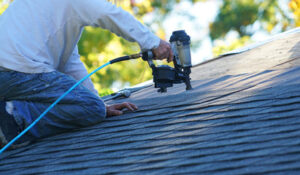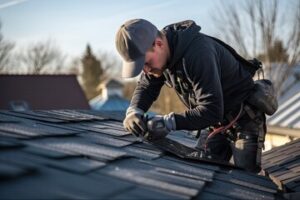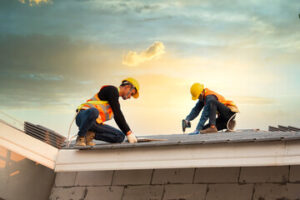Roof maintenance is all about catching problems in the bud. A small problem like a crack in the flashing can lead to expensive water damage if it’s ignored. For professional help, contact Ellingson Roofing LLC.

Debris like leaves, twigs and moss can block gutters, promote moisture infiltration, and shorten the lifespan of the roof. Interior staining can indicate leaks, as well.
Gutters are the troughs that attach to a roofline and collect and discharge rainwater, channeling it away from the house. They prevent water from accumulating on the roof and overflowing, which can damage siding, fascia, and the foundation of the home.
A gutter system also protects the roof from rot and decay, keeping it safe from moisture damage and extending its lifespan. It also minimizes the growth of moss and algae, which can weaken roofing materials over time. Lastly, it helps prevent soil erosion and flooding, safeguarding the foundation of the house and keeping crawl space issues at bay.
Gutter maintenance and cleaning are essential to ensure that the troughs work properly and are free from blockages. Clogged gutters allow debris to build up, such as leaves, twigs, and dirt. This can cause them to overflow and clog, leaving your roof with nowhere to drain. This can lead to the growth of mold, rotting fascia and soffits, and structural problems in the basement and foundation of your home.
Another important function of gutters is their ability to prevent ice dams. These form when the heat from inside your home melts snow on the roof and refreezes at the edge of the shingles, causing water to seep underneath and lead to structural issues in the home. A gutter system that is well-maintained will prevent the formation of ice dams by ensuring that water flows freely, keeping the roof healthy.
While it may be tempting to clean your own gutters, especially if you’re on a tight budget, it’s best to leave this task to professionals. A professional can safely and efficiently clear clogged gutters and prevent further damage to the troughs and surrounding structure. This will save you money in the long run, as it will prevent the need for costly repairs. At Over the Top Roofing & Restoration, we offer comprehensive gutter services that can help you keep your roof in good shape and reduce the risk of water damage to your home’s structure. Contact us to schedule your gutter cleaning and inspection today!
Shingles
The shingles on your roof protect your home from the elements. They must withstand extreme weather conditions, including heavy rains and snowfall, high winds, and scorching temperatures. To ensure that shingle roofs remain resilient and intact, homeowners must prioritize regular maintenance and address any problems promptly.
During your routine inspections, look for signs of deterioration. Damaged or missing shingles should be replaced promptly to prevent leaks and other structural issues. Also look for areas of excessive granule loss. This is an indication that the asphalt layer of a shingle roof is wearing away. Replacing these shingles can help extend the lifespan of your roof.
Additionally, a well-maintained shingle roof should be free of biological growth like moss and algae. These growths are more than just unsightly; they can cause material decay and clog gutters. To prevent these growths, regularly clean your gutters and downspouts to remove leaves and other debris that obstruct water flow. In addition, annually treat your roof with products that inhibit the growth of these organisms.
You must also check the caulk around flashing and vent pipes for deterioration or leaks. Keeping this caulk in good condition will ensure that water does not penetrate through these vulnerable points and cause leaks in your house.
Another essential part of a shingle roof is ventilation. Proper ventilation allows hot air and moisture to escape the attic, preventing damage to shingles and other roof components. If your shingle roof isn’t properly ventilated, you may experience a musty smell in the attic or see evidence of mold and mildew.
If you notice any of these issues, contact a professional roofer for repair or replacement. In many cases, repairs will be sufficient; however, in more serious situations, a complete shingle roof replacement may be required.
During the AMA’s What Doctors Wish Patients Knew series, lifestyle medicine physician Ankush Bansal discusses what patients should know about shingles. This information can help you understand this common rash and its effect on your health.
Flashing
While shingles and gutters often get the most attention, flashing is one of the most important parts of any roof. It protects critical areas of the roof where leaks are most likely to occur, such as around chimneys, vents and where the roof meets a wall. Flashing is a thin sheet of impervious material that prevents water penetration into the walls or roof and directs the flow of rainwater away from these vulnerable points.
It can be found on any part of a roof, but is especially crucial in places where the roof joins other structures such as vent pipes, dormers and chimneys. It can also be found in the valleys of a roof, where two different planes meet. Flashing can be made from a variety of materials, but metal is typically the most common choice because it can resist corrosion over time.
A roofing contractor installs flashing over the vulnerable seams of a roof. Then, it seals the edges of the flashing with a caulking compound to ensure that no water can seep in. It’s important to check the flashing regularly for signs of damage or leaking, such as rust or gaps. If these are not repaired, your roof could be at risk for extensive damage down the line.
There are many different types of flashing, and each is fabricated in a specific way. Some examples include box guttering flashing, fascia flashing and pipe flashing. Box guttering flashing is a rectangular piece of flashing that adds a decorative touch to a roof’s edge, while fascia flashing is a narrow strip of flashing installed beneath the shingles where they meet the fascia. Pipe flashing is a thin piece of impervious flashing designed to fit the cylindrical contour of tubes and pipes. It can be fabricated in a number of different ways, including using a jig to bend aluminum sheeting into the shape of the pipe or by overlapping pieces of flashing in “steps” to cover the pipe.
The most common cause of roof leaks is damaged or incorrectly installed flashing. This is why it’s so important to have your roof inspected by a professional roofing expert and to take action when needed.
Ventilation
Having proper roof ventilation is crucial for energy efficiency and overall longevity of a building’s roof. Without ventilation, the attic can become overheated and cause heat to be pushed down into living spaces, causing an air conditioning system to work much harder. In some cases, this can shorten the lifespan of an AC unit or force it to be repaired more frequently than it should. Ventilation also helps protect underlying structural parts of a building, such as wooden roof trusses and rafters, from damage due to condensation that occurs when warm air from inside the home meets cold surfaces at the top of a ceiling.
Roof ventilation systems are designed to circulate air in and out of an attic area to prevent heat loss during the winter and moisture build-up in the summer. Regular maintenance of the ventilation system includes ensuring that it is properly positioned and sealed, as well as inspecting for any debris or leaks.
A thorough roof maintenance check will also include checking for signs of water damage, such as mold and mildew, and stains or discoloration on interior walls or ceilings. Any water damage found should be addressed immediately, as it can lead to rot and other serious issues.
Regular maintenance can help property managers avoid costly emergency repairs by catching problems early. Additionally, it can help lower energy costs and increase the comfort of the space. Finally, it can help a building stand out in a competitive real estate market, as potential buyers will be able to see that the roof has been regularly inspected and maintained. For these reasons, it’s important for condominium associations and property management companies to develop a comprehensive roofing maintenance plan that they can implement across their properties. Rhino Roofing is happy to assist with this process. We can work with an existing plan or create a new one to meet the needs of each building. We also provide maintenance reports with each service visit that can be used for budgeting and forecasting. These reports can also be used to track the condition of the roof over time.

